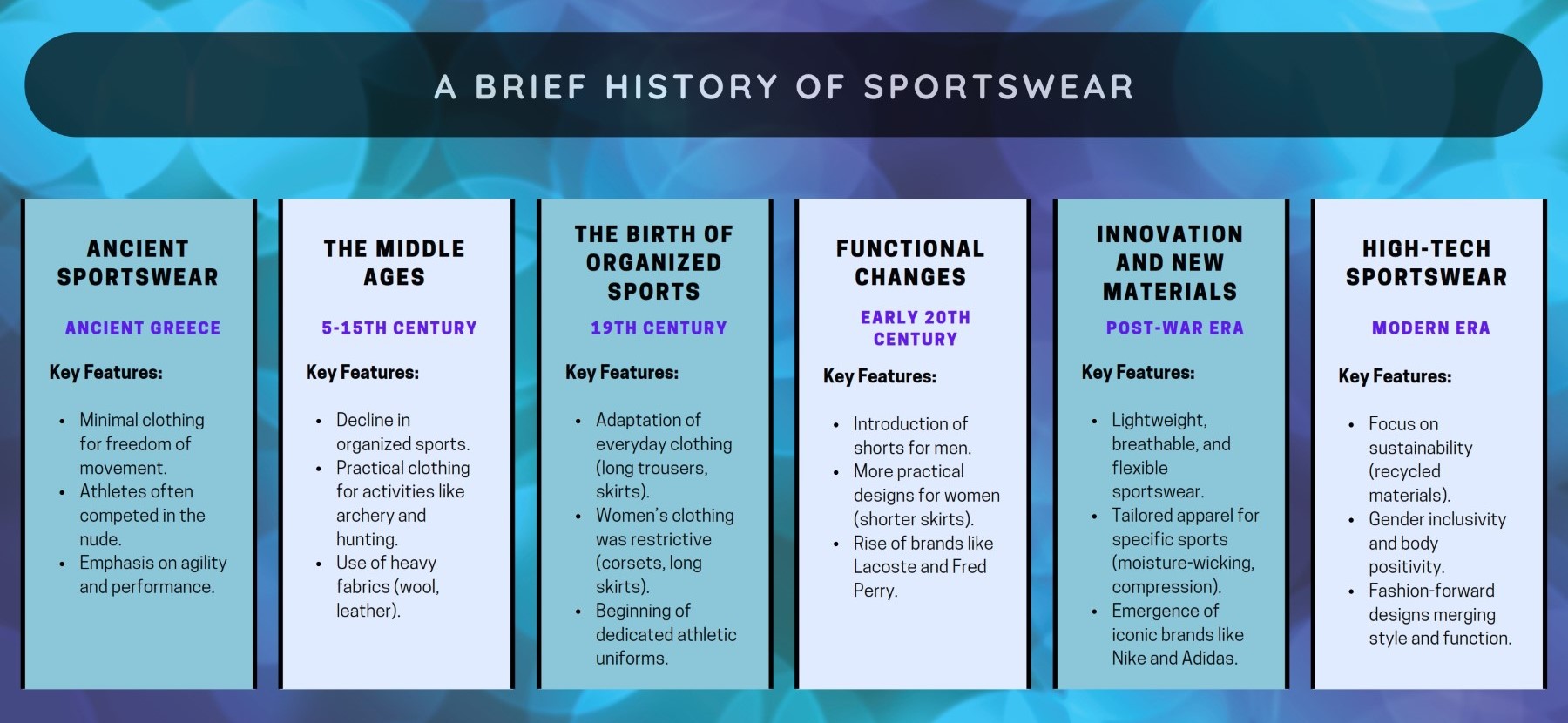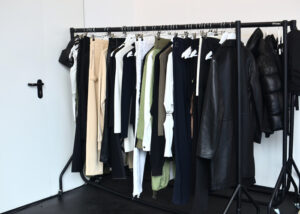History of Sportswear: A Look Back at the Evolution of Athletic Apparel

Table of Contents
ToggleAthletic apparel has come a long way, evolving alongside advancements in sports, technology, and fashion. The history of sportswear from basic garments to performance-enhancing gear highlights the growing importance of comfort, function, and style in athletic pursuits. Let’s dive into the history of sportswear and see how it has transformed over time.
1- Early Beginnings: Ancient history of Sportswear
Sports and athletic competitions date back thousands of years, with ancient civilizations engaging in various physical activities. These early sporting events laid the foundation for modern athletic culture and its apparel.
Athletic Competitions in Ancient Greece
In ancient Greece, sports held significant cultural and religious value. The Olympic Games, first held in 776 BC, were the pinnacle of these events. Athletes often competed in the nude, emphasizing the importance of freedom of movement. This practice not only celebrated the human form but also allowed athletes to perform without the hindrance of heavy or restrictive clothing.
The Role of Minimal Clothing
The minimal or non-existent clothing used by ancient Greek athletes wasn’t just symbolic—it served a functional purpose. By eliminating unnecessary garments, athletes could move more freely, showcasing their speed, strength, and agility. This focus on comfort and movement remains a core principle in modern sportswear design.
Influence on Modern Sportswear
The ancient Greek approach to athletic clothing set a precedent for future sportswear development. The emphasis on unrestricted movement and comfort continues to inspire the design of contemporary athletic apparel, from lightweight running gear to moisture-wicking fabrics that enhance performance without sacrificing mobility.
2- The Middle Ages and the Decline of Athleticism
The Middle Ages saw a significant decline in organized sports and athletic competitions, a stark contrast to the athletic culture of ancient civilizations. As a result, the development of specialized sportswear also took a backseat during this era.
Shift in Cultural Focus
During this period, the cultural emphasis shifted away from physical prowess and competitive sports, leaning more toward religious and feudal obligations. Athleticism was no longer seen as an essential part of society, which contributed to the absence of progress in the design of athletic clothing.
Activities That Required Specialized Clothing
Despite the overall decline in sports, certain activities like archery, hunting, and jousting still required functional clothing. For these pursuits, participants wore practical garments made from heavy fabrics like wool or leather. These materials offered protection from the elements and some degree of flexibility, but they were far from the lightweight, performance-driven sportswear we know today.
Early Influence on Sportswear
Although these garments were simple and utilitarian, they marked an early form of specialized clothing for physical activity. The focus on protection and durability, especially in activities like hunting, subtly laid the groundwork for the performance-based design of future sportswear.
3- 19th Century: The Birth of Organized Sports
The 19th century marked a turning point in the world of sports, as organized competitions became increasingly popular. With the rise of sports such as soccer, cricket, and tennis, a need for specialized apparel began to emerge, transforming the way athletes dressed.
Early Sports Uniforms
Initially, early sports uniforms were simple adaptations of everyday clothing. Men typically wore long trousers, button-up shirts, and blazers for sporting events. These outfits, while formal, were not conducive to high levels of physical activity. The clothing restricted movement and lacked the flexibility needed for optimal performance.
Women’s Sportswear in the 19th Century
For women, athletic apparel was even more restrictive. In sports like tennis, women wore full-length skirts, corsets, and heavy layers of fabric. These garments made it difficult for female athletes to move freely, and comfort was often sacrificed in favor of maintaining societal norms of modesty. However, women’s participation in sports gradually led to pressure for more functional clothing.
The Rise of Sports as a Cultural Phenomenon
As sports gained cultural significance and attracted spectators, the importance of specialized sportswear became clearer. This period laid the foundation for the development of dedicated athletic clothing, as people began to realize that comfort and movement were crucial to improving performance. The rise of sports uniforms tailored to specific activities was a significant milestone in the evolution of sportswear.

4- Early 20th Century: Functional Changes
The early 20th century brought a wave of innovation and modernization to sportswear, as both social norms and technological advancements began to shape the way athletes dressed. This era marked the shift from restrictive, formal clothing to more practical, performance-oriented designs.
Materials: Wool and Cotton
At the beginning of the century, wool and cotton were the dominant materials used in sportswear. These natural fibers provided comfort and breathability but were often heavy and absorbed moisture, which limited their effectiveness during intense physical activity. Despite these limitations, they were the foundation of early athletic clothing, gradually evolving into lighter and more functional designs.
The Introduction of Shorts and Practical Women’s Wear
One of the major developments in early 20th-century sportswear was the introduction of shorts for men, particularly in sports like tennis and soccer. This was a significant step forward, as it allowed for increased mobility and comfort. At the same time, women’s sportswear also underwent functional changes. Shorter skirts and blouses replaced the cumbersome, layered outfits of the previous century, providing women with more freedom to move, and marking the beginning of more practical athletic clothing for female athletes.
Emergence of Sports Brands
During this period, iconic sportswear brands like Lacoste and Fred Perry began to emerge. These brands were among the first to introduce sports-specific clothing lines, creating items like polo shirts, which became a staple in sports like tennis and golf. The focus was not just on comfort and performance but also on style, blending fashion with functionality in athletic wear.
Comfortable Footwear
In addition to clothing, the early 20th century saw a growing emphasis on comfortable footwear. Shoes designed specifically for sports like tennis, soccer, and running began to appear, offering better support and grip, further enhancing athletes’ performance.
This period laid the groundwork for modern sportswear by focusing on practicality, comfort, and performance, allowing athletes to excel in their chosen sports.
5- Post-War Era: Innovation and New Materials
The period following World War II marked a revolutionary shift in sportswear design and technology. With advancements in synthetic materials and an increasing global interest in sports, this era laid the foundation for the modern, high-performance athletic apparel we see today.
The Introduction of Synthetic Fibers
The post-war era saw the widespread use of synthetic fibers like nylon, spandex, and polyester in sportswear. These materials were lighter, more flexible, and far more breathable than traditional fabrics like cotton and wool. Nylon offered strength and durability, spandex introduced unparalleled stretch, and polyester was prized for its moisture-wicking properties. This made synthetic fabrics ideal for creating sportswear that could enhance athletic performance in a variety of sports.
Specialized Apparel for Specific Sports
With these innovations, sportswear began to be tailored to the unique demands of specific activities. For instance, moisture-wicking jerseys became essential in sports like soccer, helping to keep players cool and dry during intense matches. In swimming, elastic swimwear made from lightweight synthetic fabrics drastically improved swimmers’ speed and mobility, allowing for better performance in competitive swimming events. This focus on sport-specific apparel transformed sportswear into performance-enhancing gear rather than just casual clothing.
Emergence of Iconic Sports Brands
By the 1960s and 1970s, brands like Nike, Adidas, and Puma emerged as pioneers in the sportswear industry. These companies revolutionized athletic apparel by combining cutting-edge technology with fashion-forward designs. For example, Nike introduced innovative footwear with air-cushioned soles, Adidas developed lightweight tracksuits, and Puma created comfortable, stylish sneakers. These brands not only influenced performance on the field but also integrated sportswear into mainstream fashion.
The Intersection of Technology and Fashion
As these brands rose in prominence, they set a new standard for sportswear, focusing on both technical innovation and aesthetic appeal. The idea of blending fashion with functionality became a hallmark of the post-war era, with athletes and non-athletes alike embracing sportswear for its style, comfort, and performance. This era marked the beginning of the sportswear industry’s massive global growth, where technology-driven designs became the norm.
This period of innovation transformed sportswear from basic, functional attire into performance-focused apparel, laying the groundwork for the high-tech, stylish sports clothing we see today.
6- 1980s-1990s: The Rise of Athleisure
The 1980s and 1990s were pivotal decades in the evolution of sportswear, as the athleisure trend took off. No longer confined to the gym or the playing field, sportswear became an integral part of everyday fashion, leading to a cultural shift in how athletic apparel was perceived and worn.
Athleisure: Blurring the Lines
The athleisure movement blurred the boundaries between sportswear and casual wear. Items like track suits, sneakers, and branded athletic apparel became staples in streetwear, embraced by athletes and non-athletes alike. Fashion and function were no longer mutually exclusive, with sportswear offering both style and comfort. The versatility of athleisure allowed individuals to seamlessly transition from workouts to casual outings, making it a defining trend of the era.
Athletes as Fashion Icons
This period also saw the rise of athletes as global fashion icons. Sports stars such as Michael Jordan, Andre Agassi, and Bo Jackson became trendsetters, influencing not just the world of sports but also fashion. Endorsement deals with major brands like Nike, Adidas, and Reebok positioned athletes as ambassadors of athleisure, leading to widespread adoption of athletic wear in mainstream fashion.
The Impact of Nike and the Air Jordan Phenomenon
One of the most significant milestones of this era was the introduction of the Nike Air Jordans in 1984. Designed for basketball legend Michael Jordan, Air Jordans were more than just basketball shoes—they were a cultural phenomenon. The sneaker line not only revolutionized sports footwear with its cutting-edge design and performance features, but it also turned Jordan into a fashion icon, fueling the rise of sneaker culture. This marked a turning point in the commercialization of sportswear, with branded athletic gear becoming a coveted part of popular culture.
Branded Apparel as a Status Symbol
In the 1980s and 1990s, branded sportswear—whether it was a pair of Nike sneakers, an Adidas tracksuit, or a Reebok windbreaker—became a status symbol. Wearing these brands signified not only a commitment to an active lifestyle but also a connection to the global sports culture. This rise of branded apparel as fashionable streetwear laid the foundation for the dominance of athleisure in the years to come.
The rise of athleisure in the 1980s and 1990s transformed sportswear into a cultural and fashion phenomenon, changing the way people dressed and influencing future generations of athletic apparel design.

7- Modern Era: High-Tech and Sustainable Sportswear
In the modern era, sportswear has entered a new phase of innovation, driven by advancements in technology and a growing demand for sustainability. Today’s athletic apparel is designed not only to enhance performance but also to meet the evolving ethical standards of consumers.
High-Performance Materials and Smart Fabrics
At the forefront of modern sportswear are high-performance materials that combine cutting-edge technology with functionality. Smart fabrics equipped with built-in sensors can now track athletes’ heart rates, body temperature, and other metrics in real time. This technology helps athletes monitor their performance, allowing for more personalized training and recovery programs. Additionally, compression garments have become a key part of sportswear, improving blood circulation, reducing muscle fatigue, and speeding up recovery times.
The Push for Sustainable Sportswear
As environmental concerns grow, the sportswear industry is shifting towards more sustainable practices. Brands are increasingly using recycled polyester, organic cotton, and biodegradable materials to create eco-friendly apparel. This shift addresses the increasing demand for ethical and environmentally responsible products. Many companies are also adopting closed-loop recycling processes, ensuring that used sportswear is repurposed or recycled, reducing waste and minimizing their carbon footprint.
Gender Inclusivity and Body Positivity
Modern sportswear is also making strides in gender inclusivity and body positivity. Brands are designing apparel that caters to athletes of all shapes, sizes, and gender identities. From expanded size ranges to gender-neutral collections, sportswear companies are ensuring that their products are inclusive, promoting body confidence and empowering athletes of all types. This focus on inclusivity has also extended to adaptive sportswear for individuals with disabilities, ensuring that performance-enhancing gear is accessible to everyone.
Fashion-Forward Design
Sportswear has continued to embrace fashion-forward elements, blending style with functionality. Athleisure remains a dominant trend, and brands collaborate with designers and fashion houses to create stylish activewear that is equally at home on the streets as in the gym. Bold designs, unique prints, and sleek silhouettes ensure that modern sportswear is not only highly functional but also a reflection of personal style.
As technology and sustainability continue to drive
innovation, modern sportswear remains at the cutting edge of both fashion and performance, offering athletes the tools they need to excel while staying mindful of the environment and promoting inclusivity.
The Future of Sportswear
From its humble beginnings in ancient Greece to the advanced, technology-driven apparel of today, sportswear has evolved to meet the changing needs of athletes and society. As we move forward, expect further innovations in sustainable materials, wearable tech, and designs that cater to all athletes. The fusion of fashion and function remains a key driving force in the sportswear industry, ensuring that the journey of athletic apparel is far from over.
At Arbish Sports, based in the heart of Sports City, Sialkot, Pakistan, we are proud to contribute to this evolution. By utilizing the latest production techniques and specialized fabrics, we manufacture high-quality sportswear that meets the demands of modern athletes. Whether you’re training or competing, our apparel is designed to enhance your performance while ensuring comfort and durability.
- Facebook
- Twitter
- Linkedin
- Whatsapp





